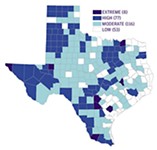A Downtown Plan
Who decides?
By Katherine Gregor, Fri., July 21, 2006
– "Heritage Austin: A Community-Based Vision"
What role, if any, should the city of Austin take in helping small, locally owned businesses like Las Manitas, Escuelita del Alma, Copa, and Tesoros stay downtown? Should it step in or stand back?
"This situation raises interesting policy questions on many levels, and we're going to have to struggle through that," concedes Michael Knox, the city's principal downtown planner. "What is government's role when an important community asset is privately owned? We have policies in place for designating historic landmarks, but 'cultural landmarks' don't really have a process. So council faces a lot of tough decisions that are one-of-a-kind."
Even the criteria for historic landmark designation are plenty subjective. A property can be so designated if it has "community value" and "historical associations." Playing devil's advocate, real estate broker and developer Robert Knight asks, "What does it take to become an icon? Is it time, who ate there, what they did, or is it just if the glitterati want it to be so? Is Matt's an icon? Is Maudie's? Is the Cedar Door? At which location?
"Is every place Lady Bird ever ate an icon?" asks Knight, whose past clients include the Finley Company. "If not, what makes some icons and others not? Is the Austin Country Club, founded in 1899, an icon? Is every place Willie ever sang? Who decides?"
Knox notes that a whole shelf in his city Economic Growth and Redevelopment Services Office is taken up by the plethora of downtown plans, master plans, guidelines, and reports issued over the past 20 years. Yet council still has no definite rule to apply when, say, a quality day care center loses its lease in a privately owned, quasi-historic building.
Knox hopes that the city's new Austin Downtown Plan – to be created by a fresh team of urban planners selected by council this summer, and paid for with $400,000 allocated for Neighborhood Plans – will finally provide council with a set of clear, consistent principles to guide decision making. (See www.ci.austin.tx.us/downtown.) "City departments and developers need to know what the rules are," Knox points out. Charlie Betts at the Downtown Austin Alliance says the same is true for the property owners that DAA represents.
At this juncture, Knox explains, "Council wants something that can actually change the code – that's adoptable, implementable, and specifies zoning changes. We need to determine which parts of the past plans are still relevant. Where are we going? We need to get it in the code, because we're going there pretty fast."
Got something to say on the subject? Send a letter to the editor.








